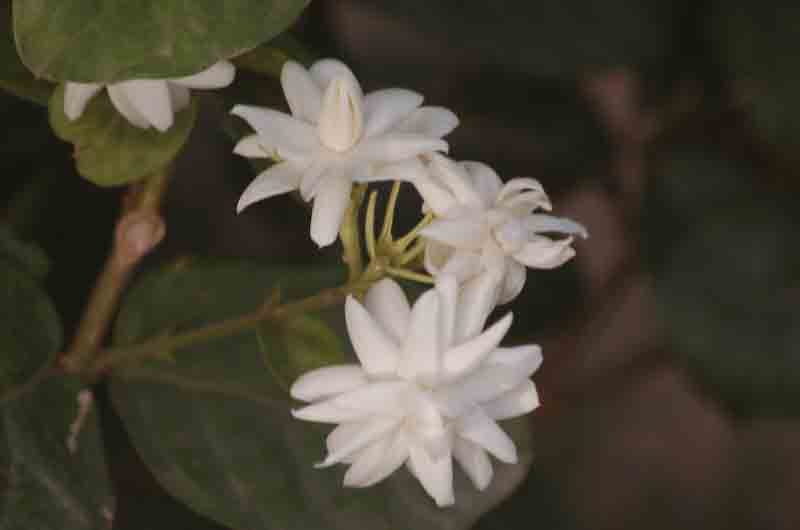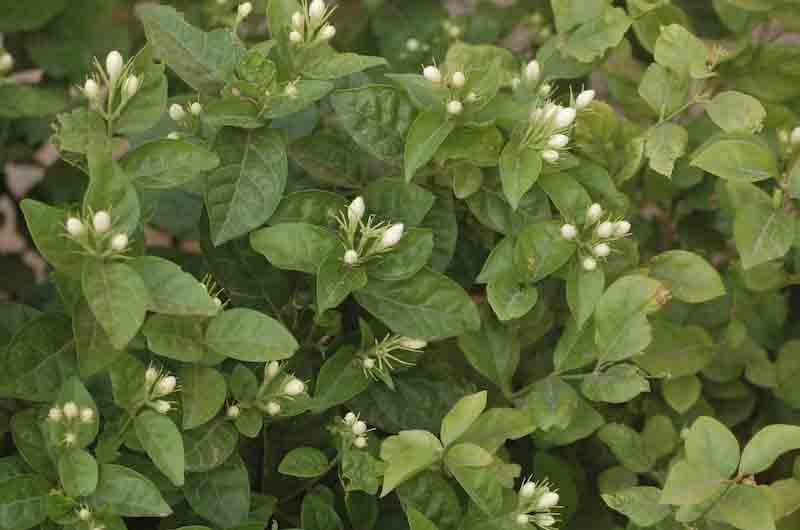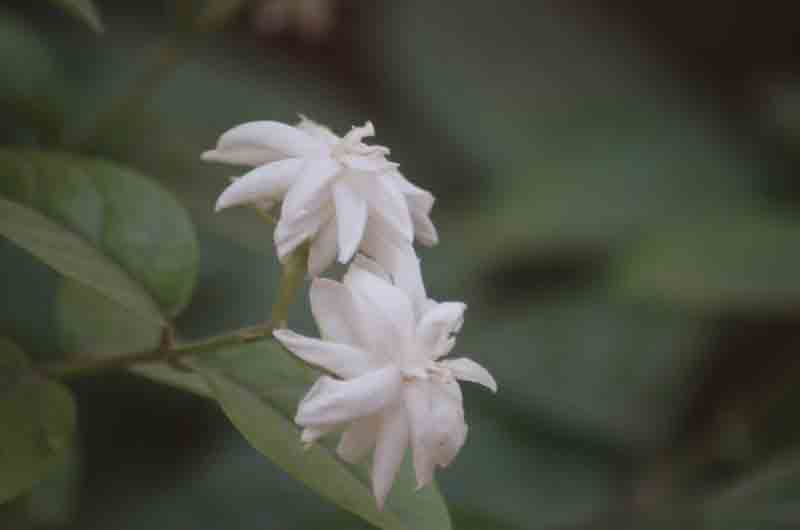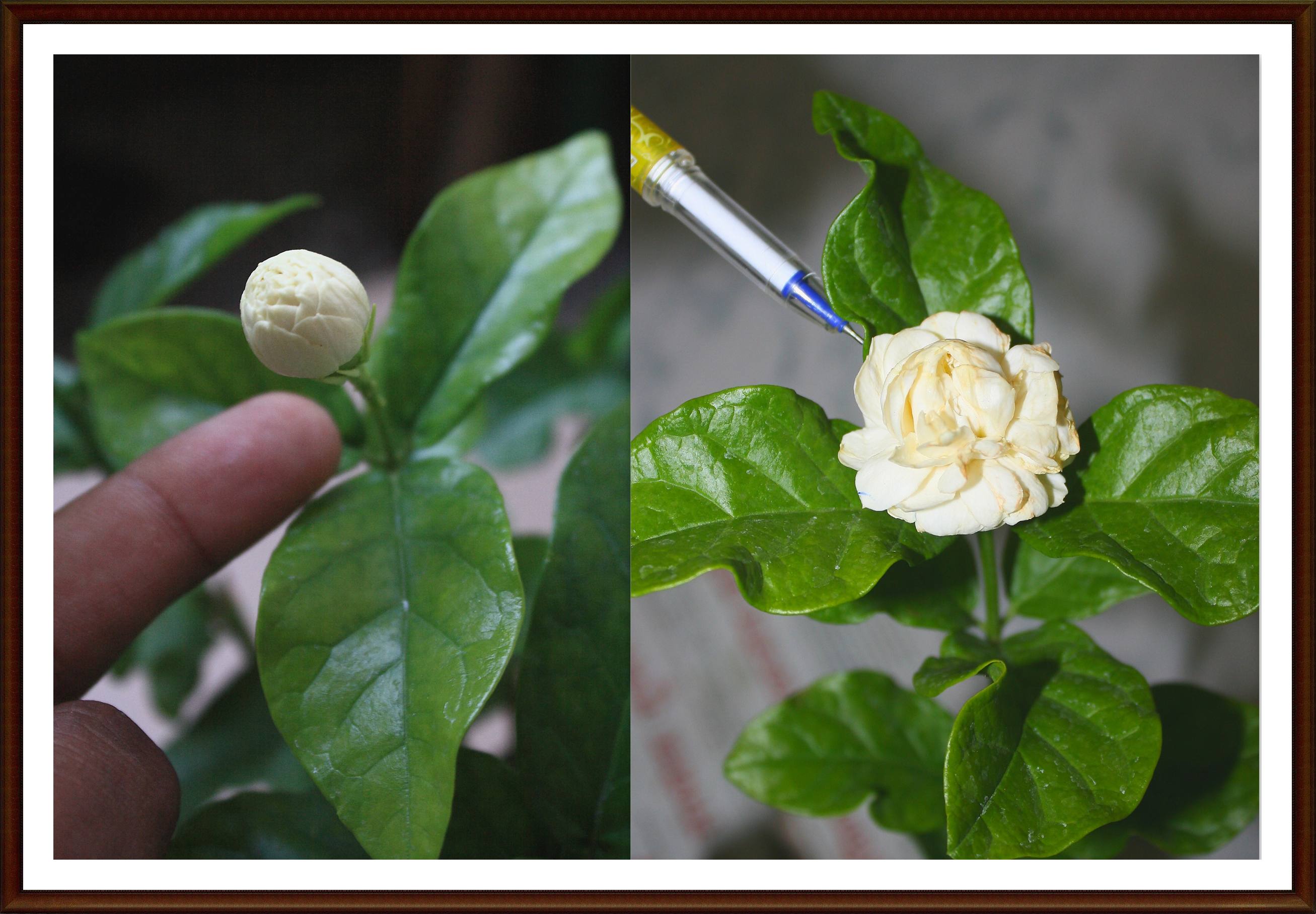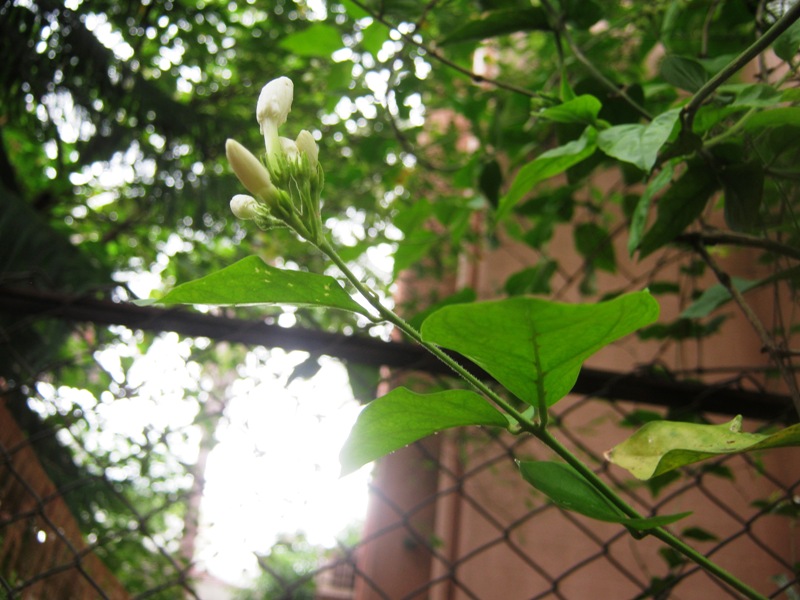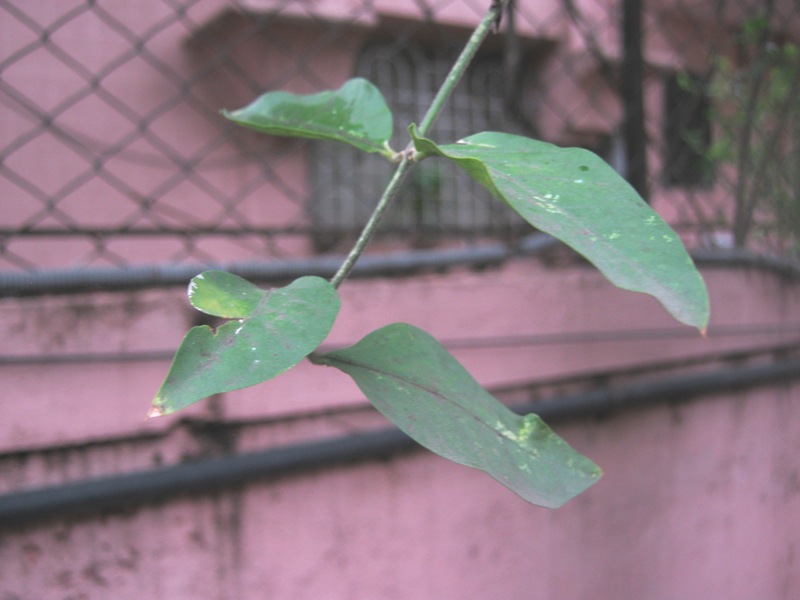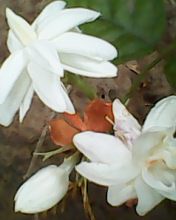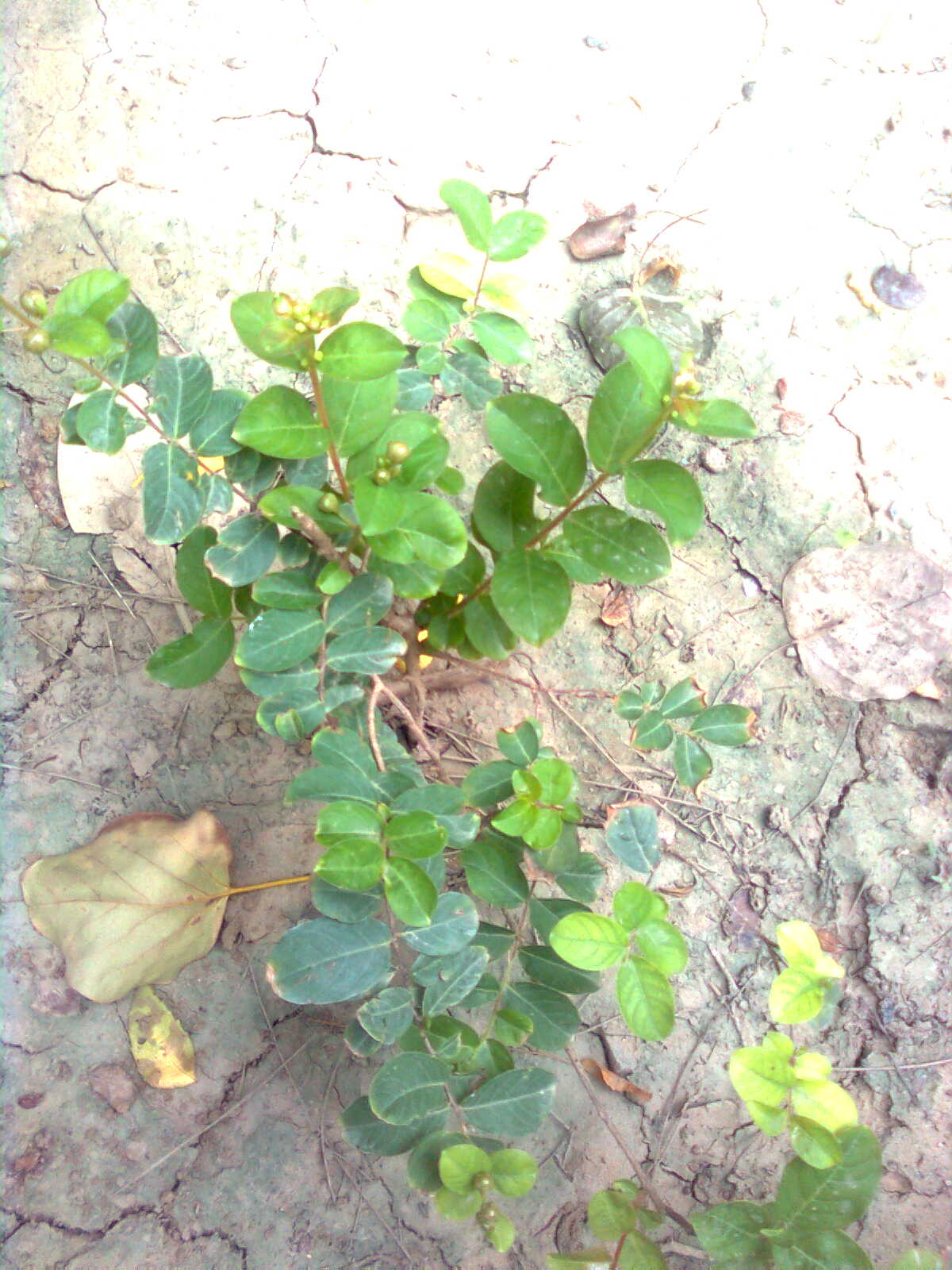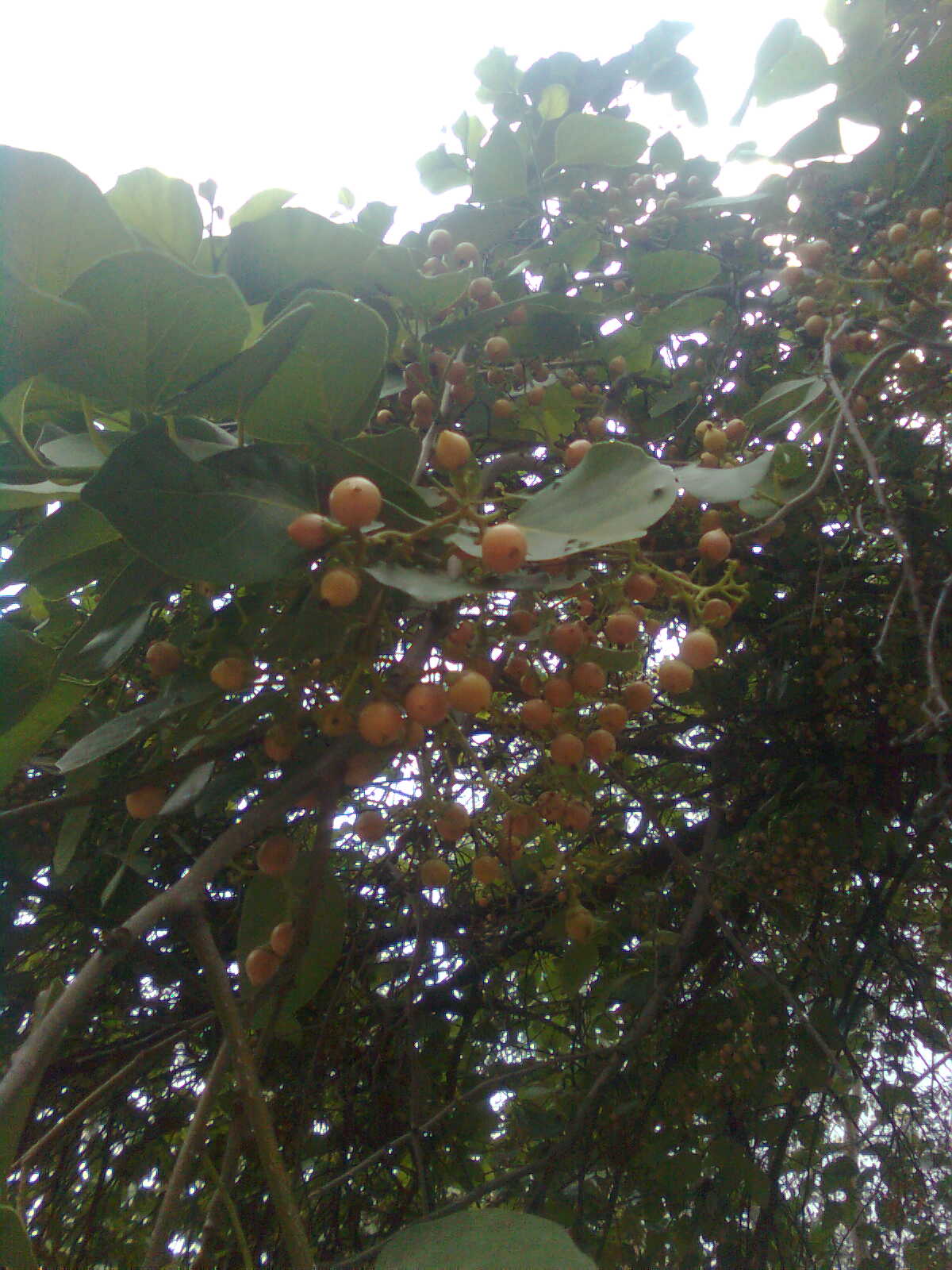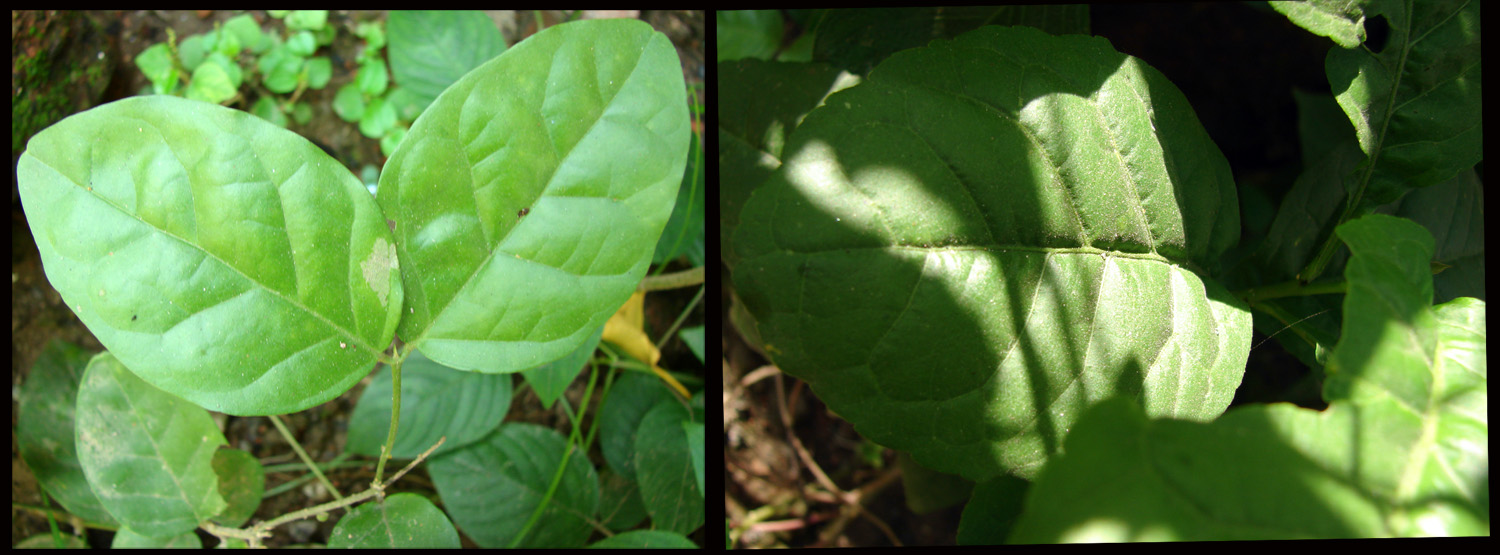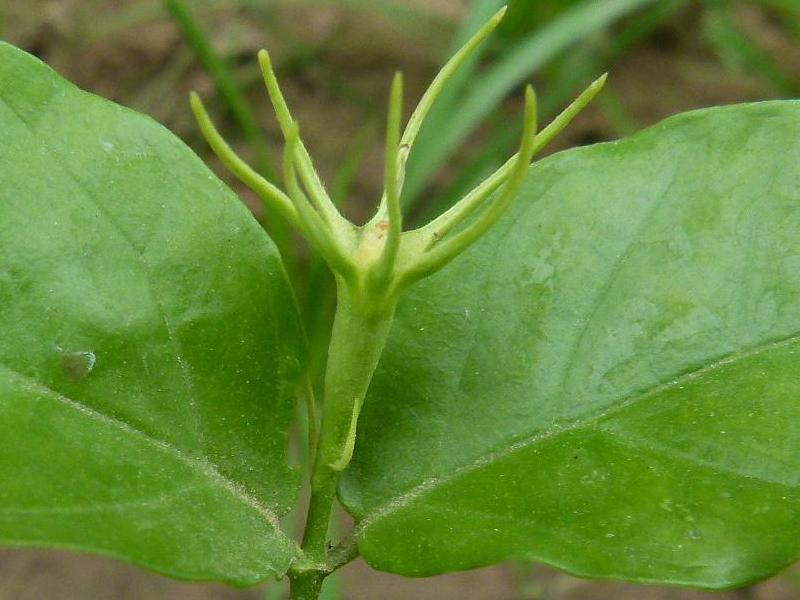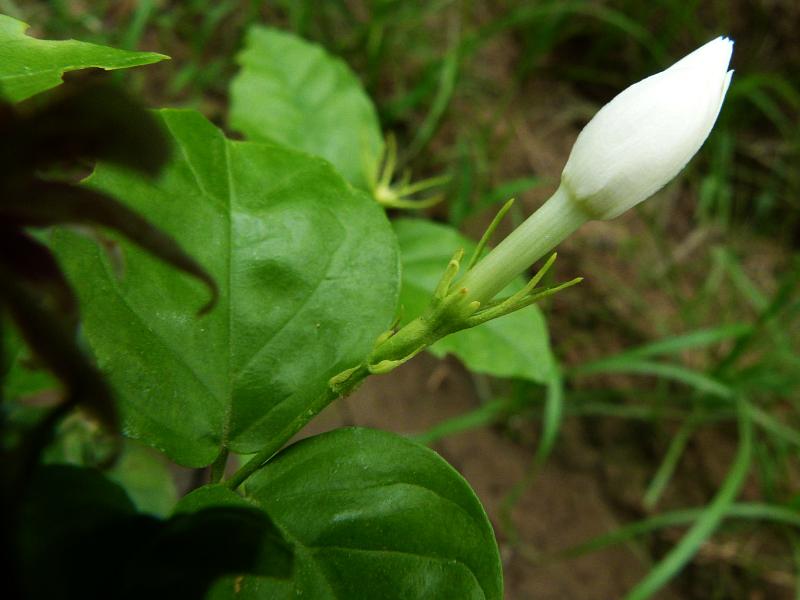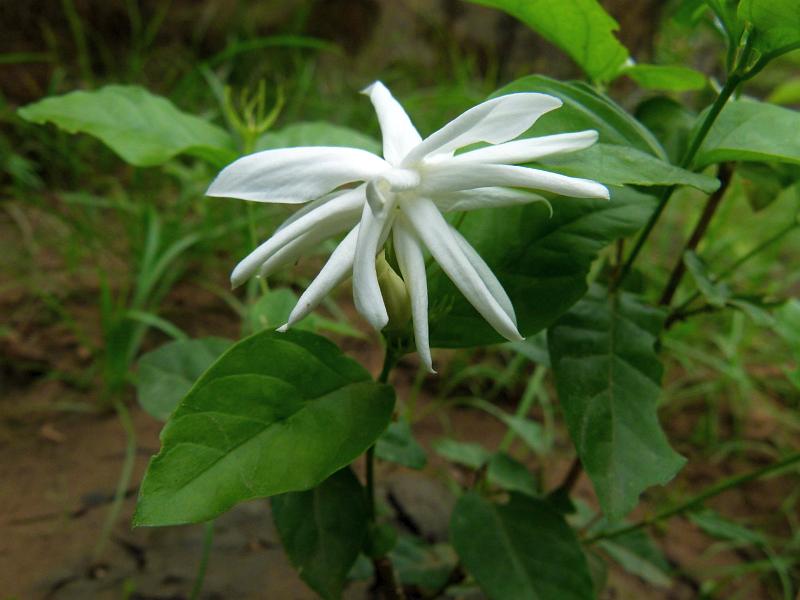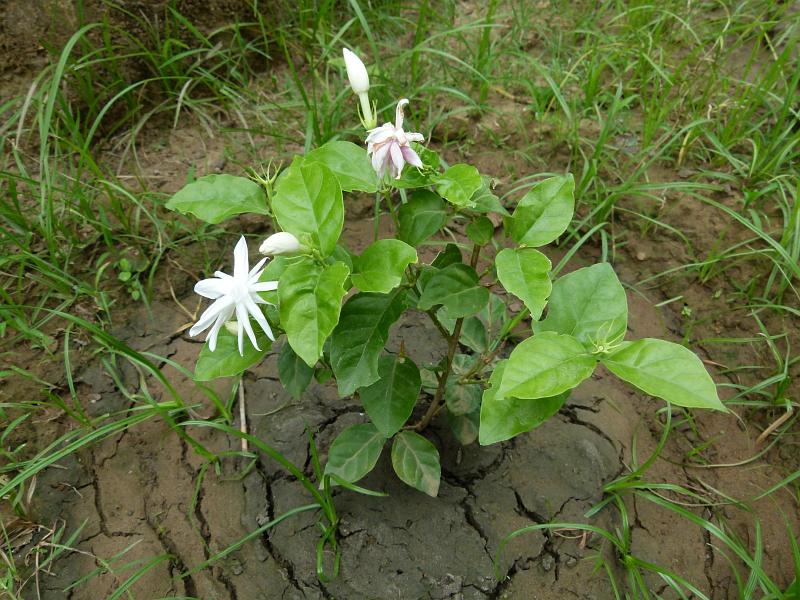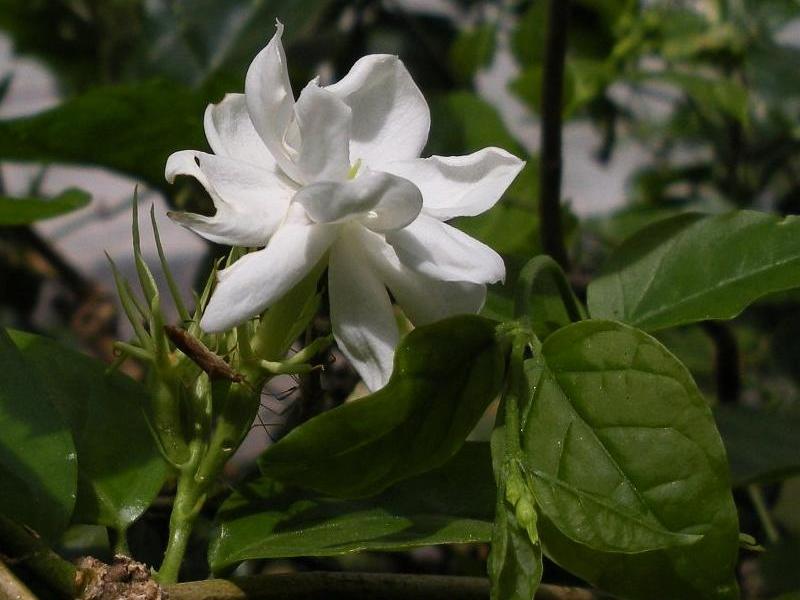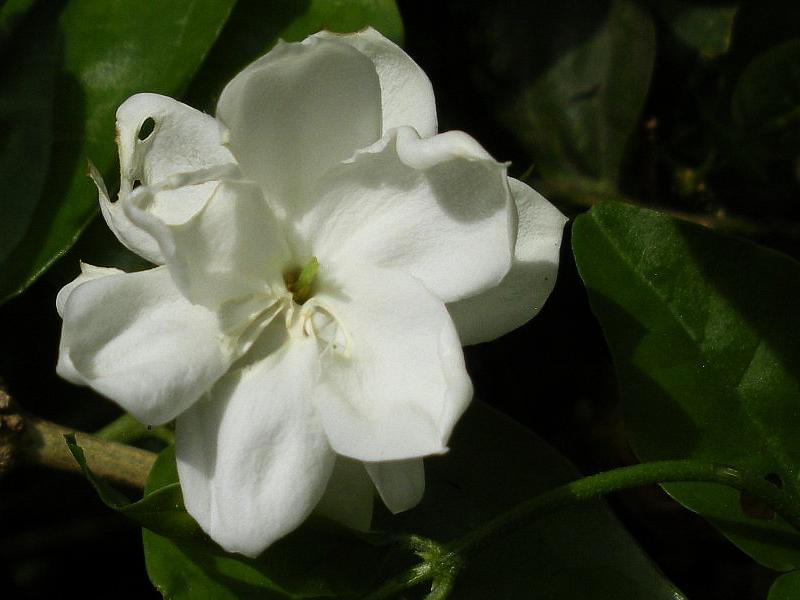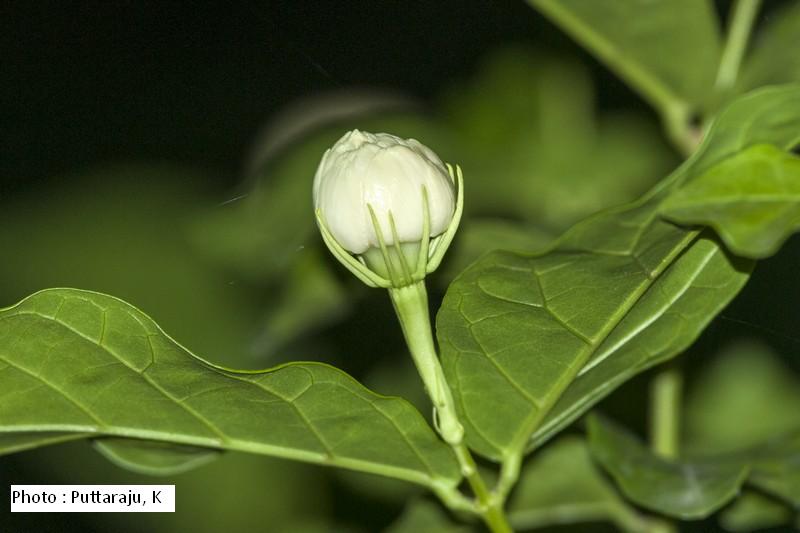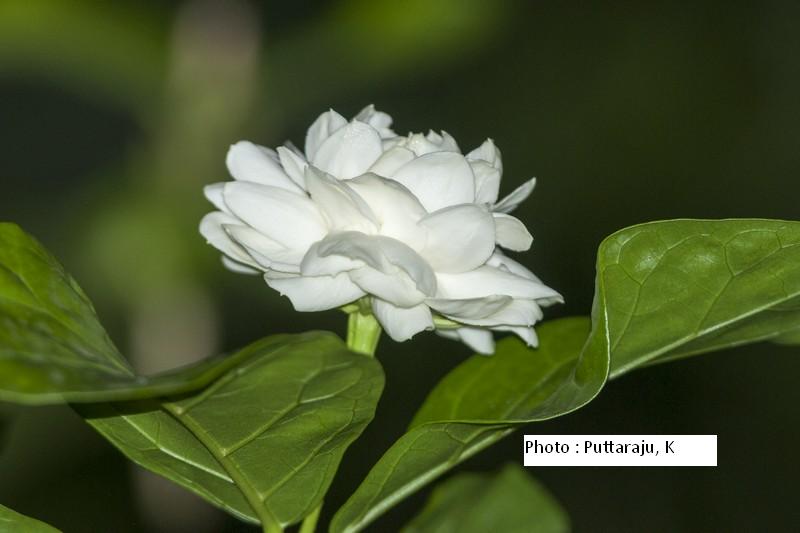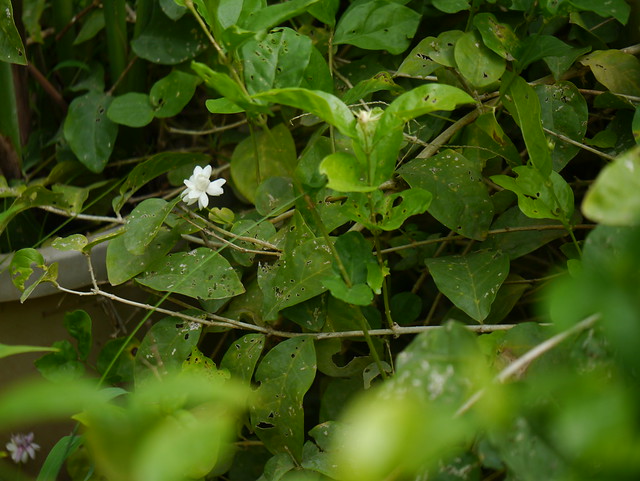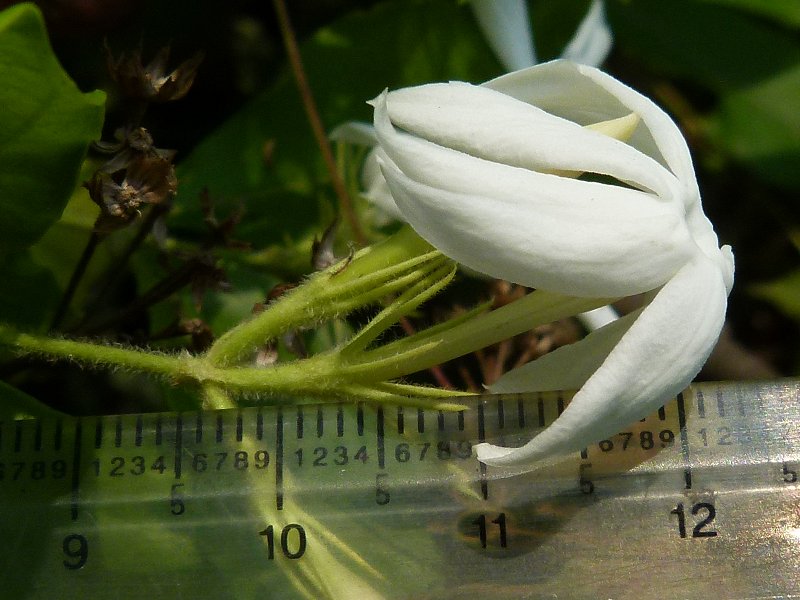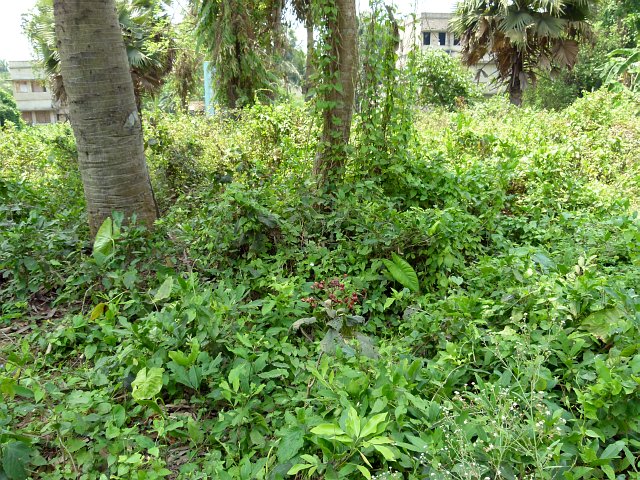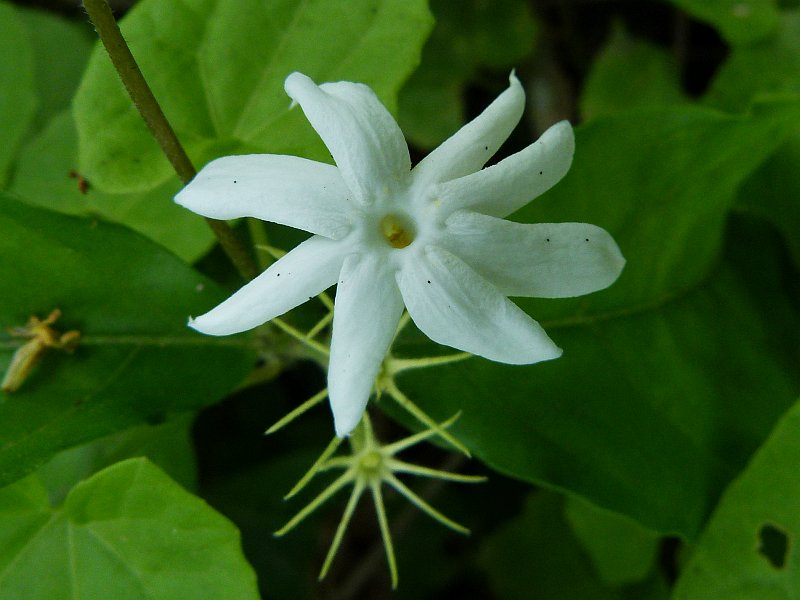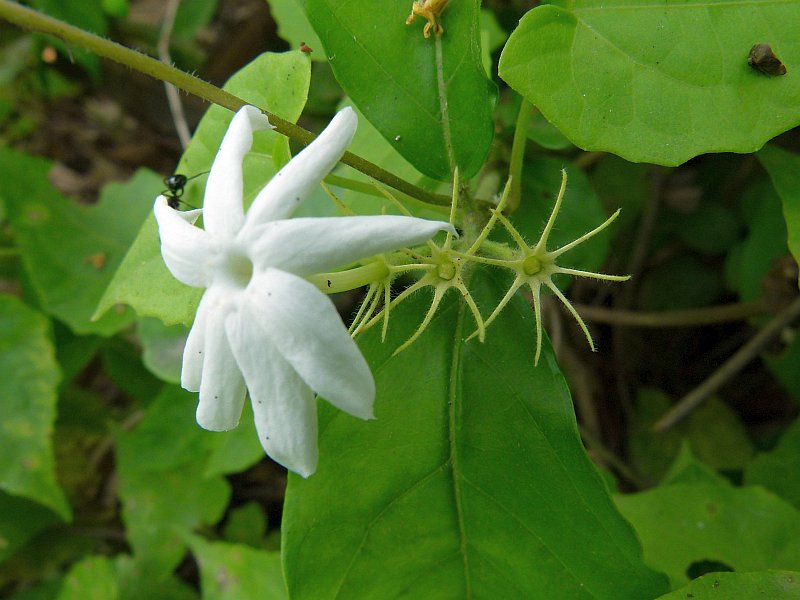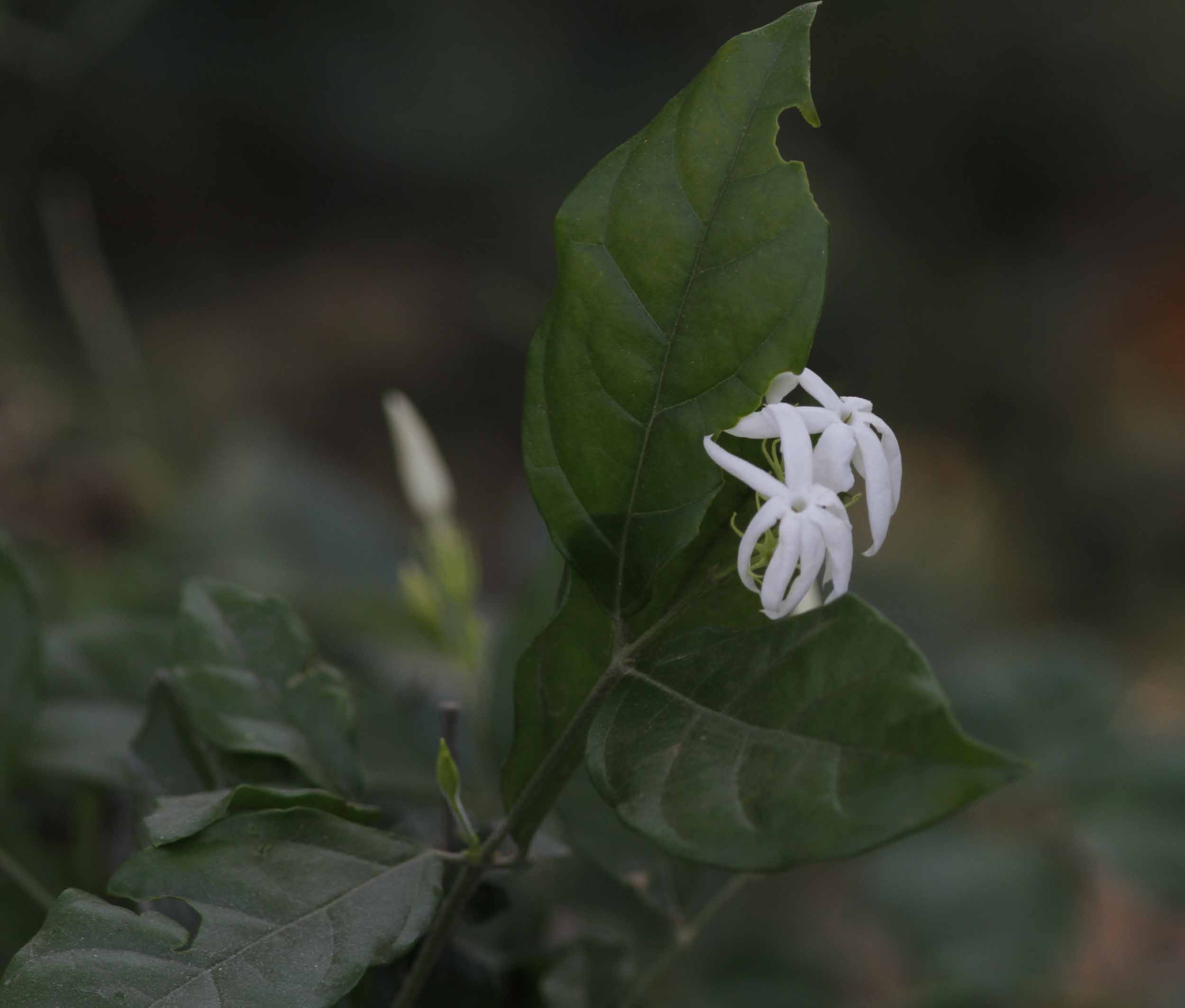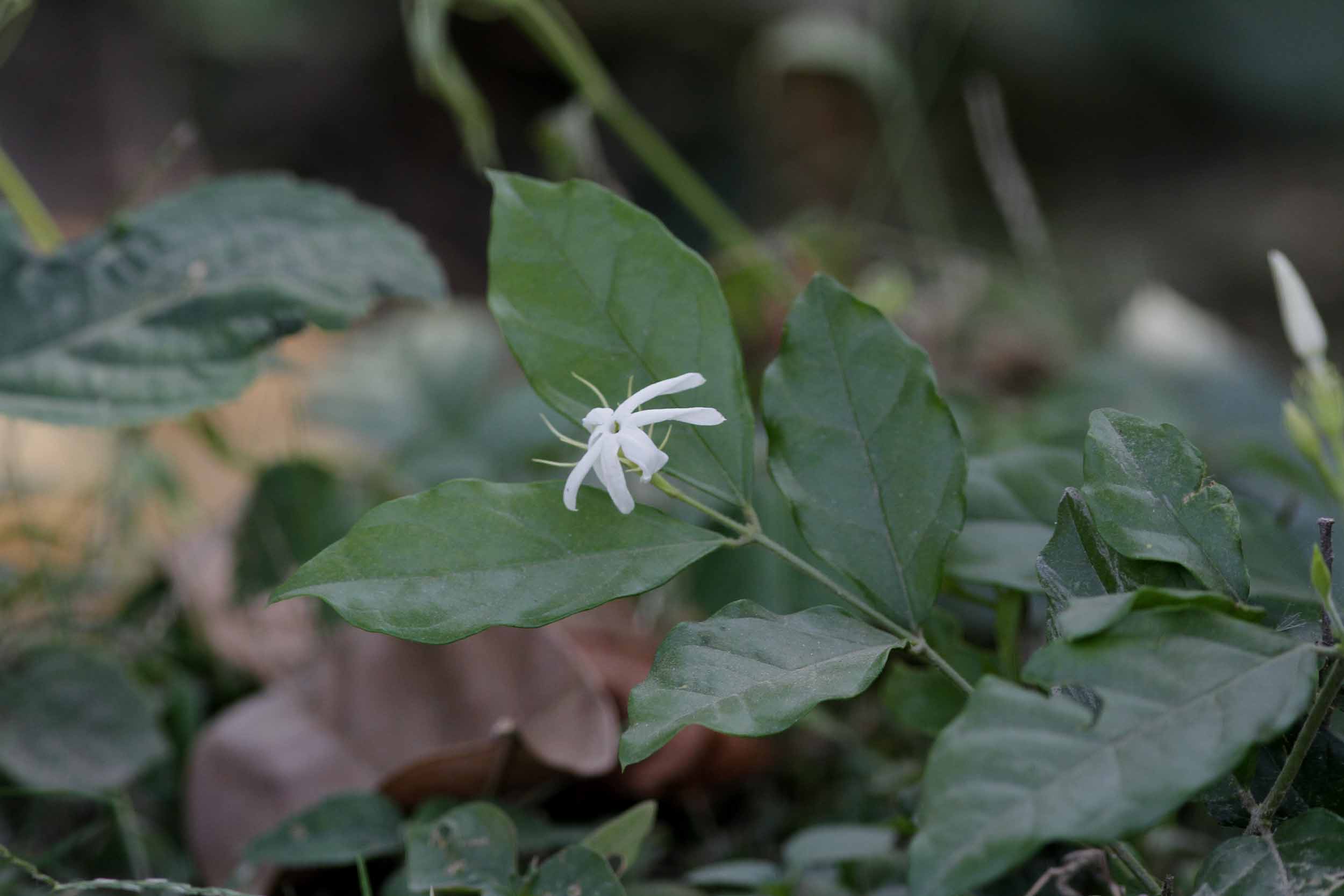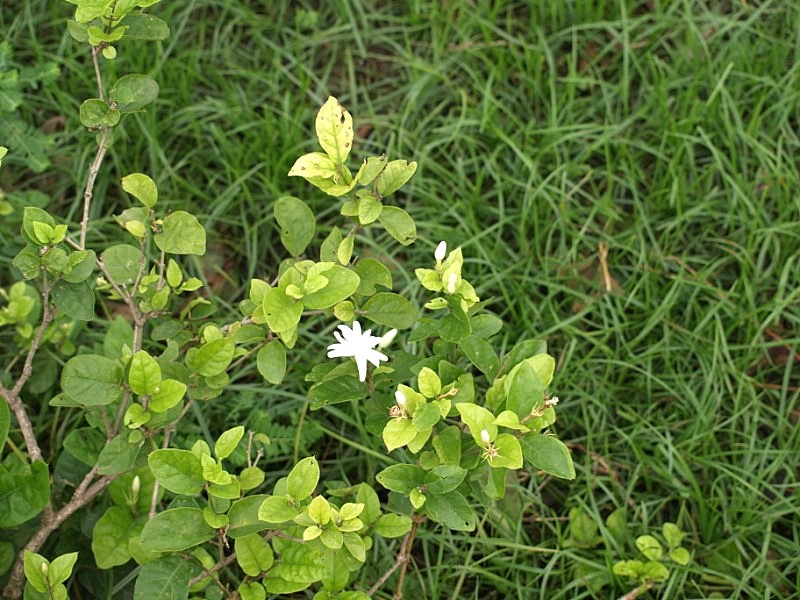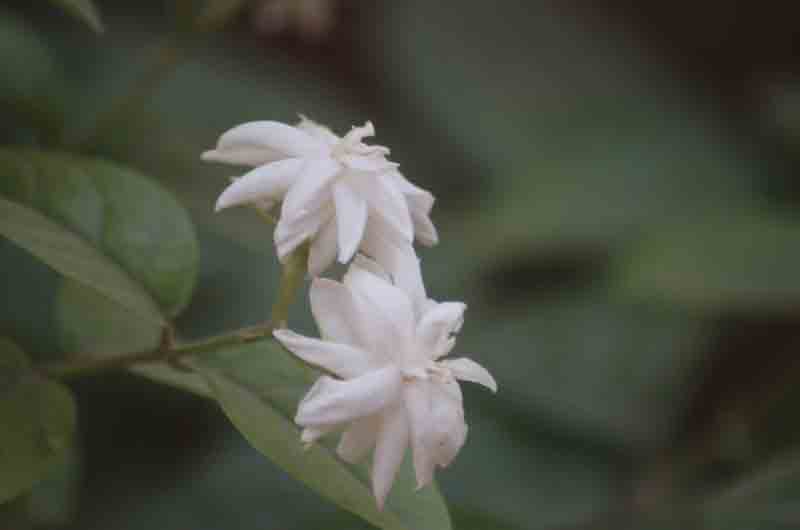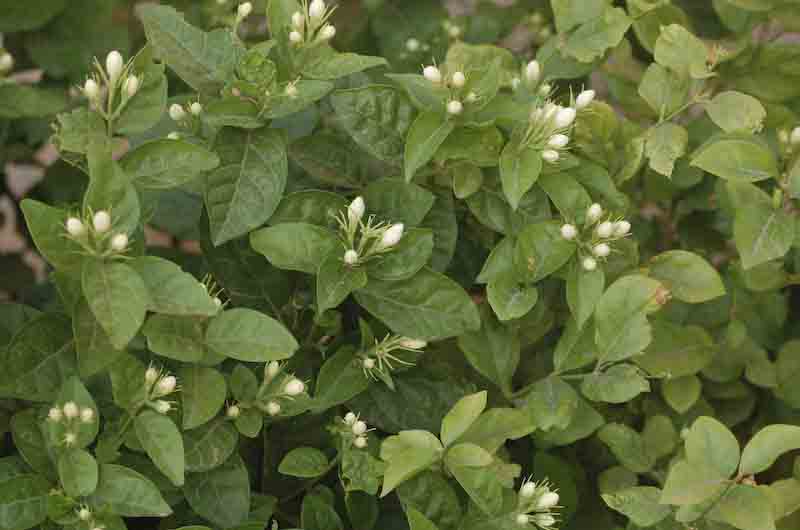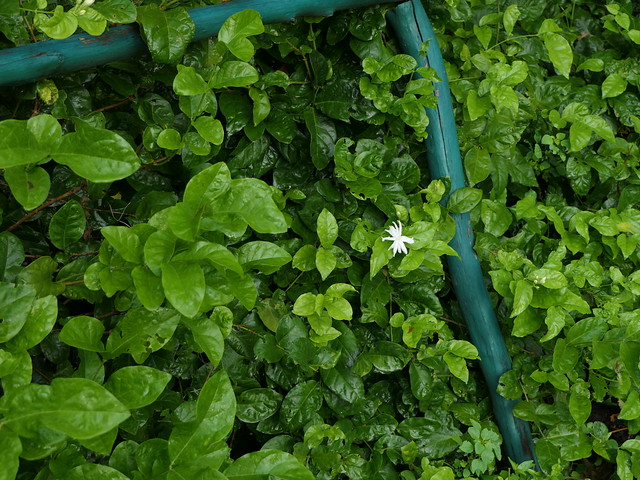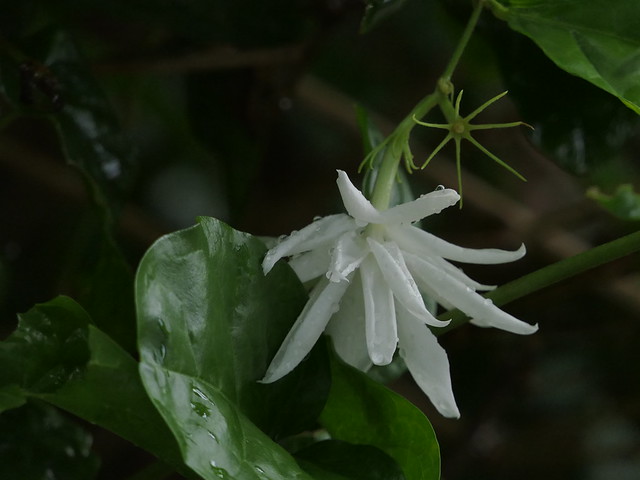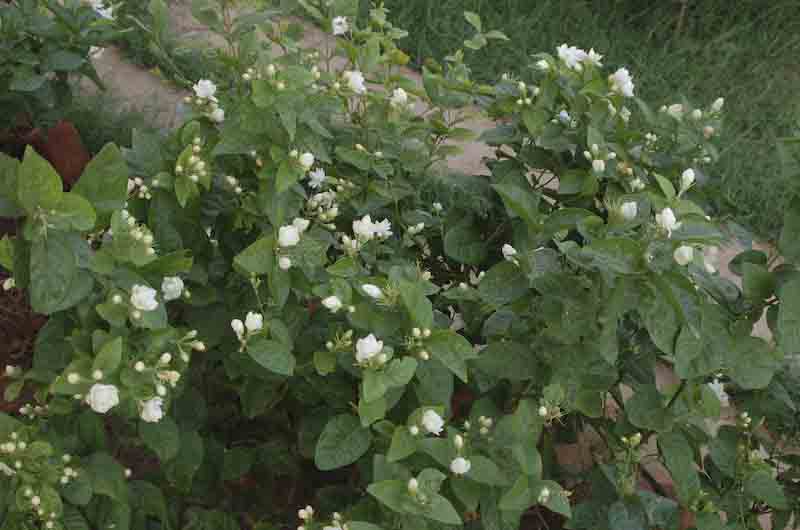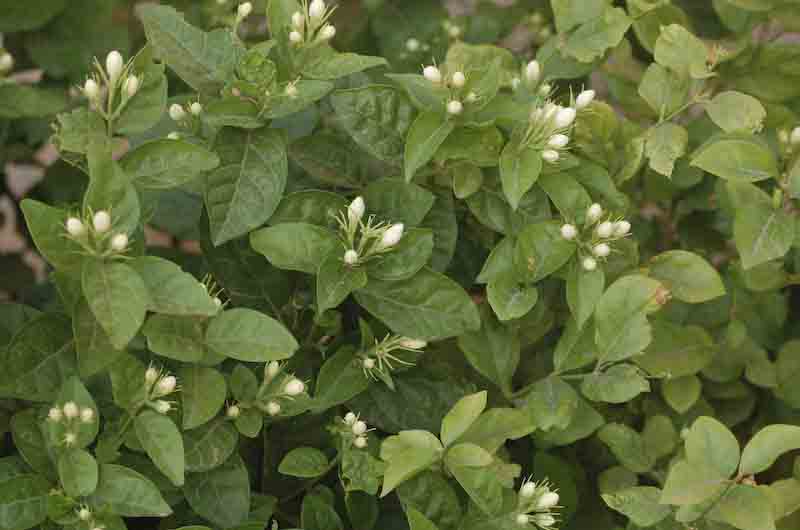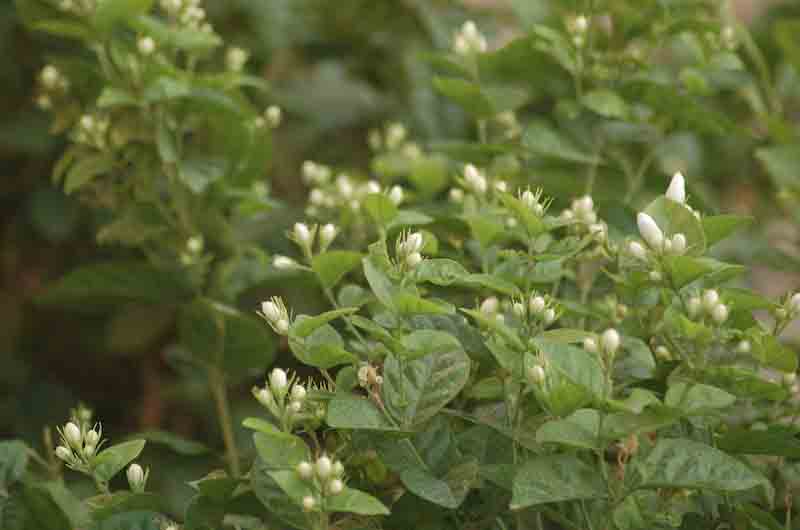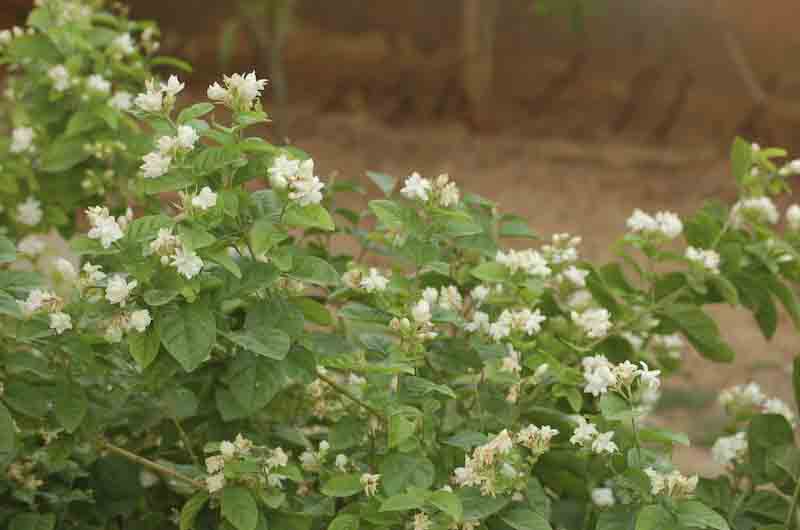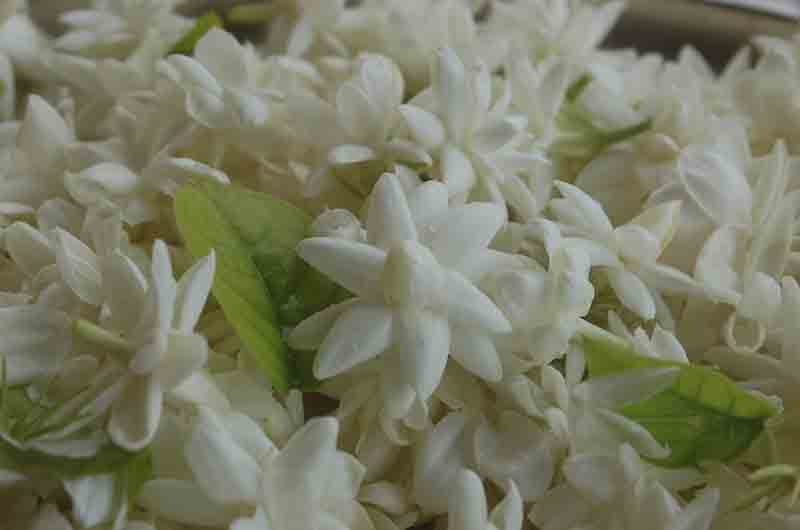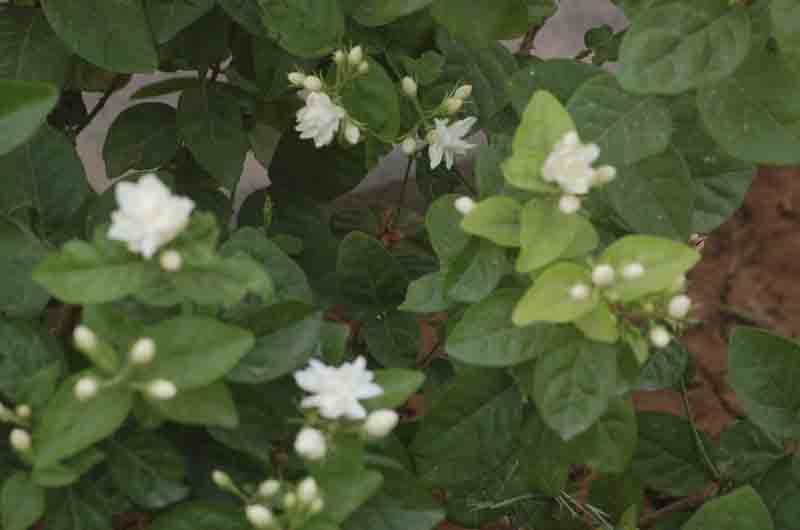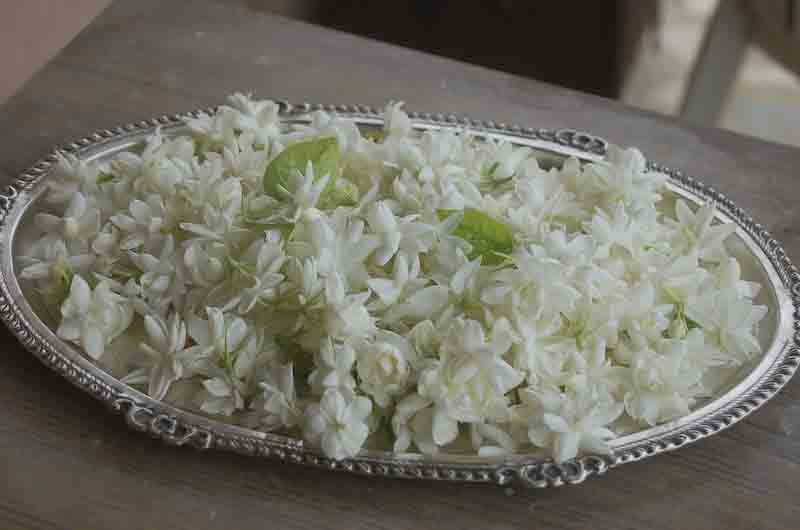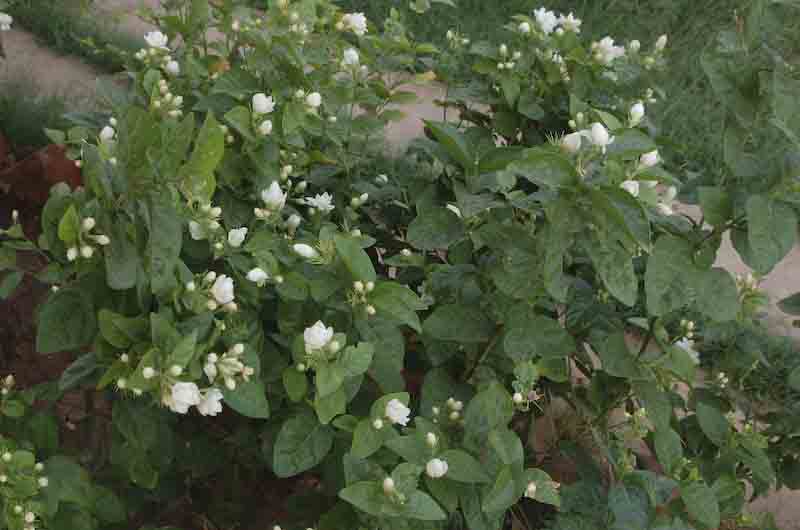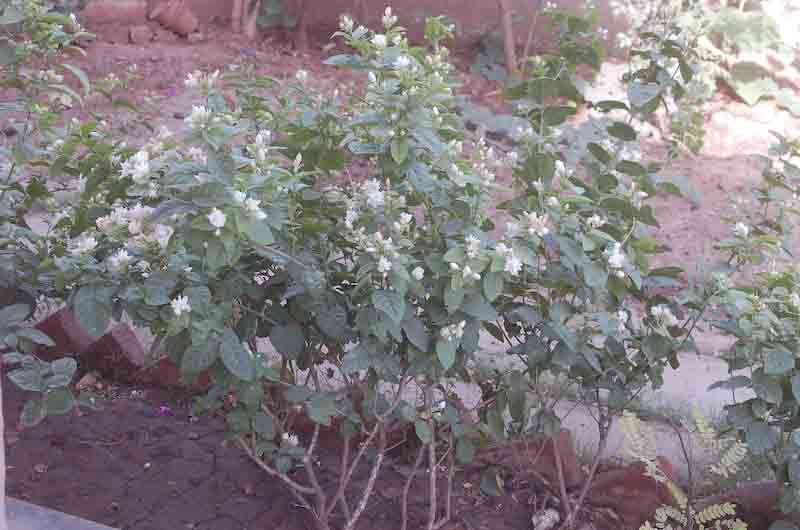|
Jasminum sambac (L.) Sol., Hort. Kew. 1: 8 1789. (syn. Jasminum bicorollatum Noronha; Jasminum blancoi Hassk.; Jasminum fragrans Salisb. [Illegitimate]; Jasminum heyneanum Wall. ex G.Don; Jasminum odoratum Noronha; Jasminum pubescens Buch.-Ham. ex Wall. [Invalid]; Jasminum quadrifolium Buch.-Ham. ex Wall. [Invalid]; Jasminum quinqueflorum B.Heyne ex G.Don .; Jasminum sambac var. duplex Voigt …………; Jasminum sanjurium Buch.-Ham. ex DC. [Invalid]; Jasminum undulatum (L.) Willd.; Jasminum zambac Roxb. [Spelling variant]; Mogorium gimea Zuccagni; Mogorium goaense Zuccagni; Mogorium sambac (L.) Lam.; Mogorium undulatum (L.) Lam.; Nyctanthes goa Steud.; Nyctanthes sambac L.; Nyctanthes undulata L.);
.
.
Motiya, But Mogra, Bela, Motiya, Mallikā, Mallepuvvu, Mallikaipu, Mallige, Kaliyan, Arabian Jasmine, Asian Jasmine, Asiatic Jasmine, Sacred Jasmine, Sambac Jasmine • Hindi: Madan mogra मदन मोगरा • Tamil: குஂதூ மல்லீ Gundu Malli, • Telugu: Malli • Tamil: கொடி மல்லி Kodi mulli • Manipuri: Jati জাতী পুশ্প pushpa;
.
large size jasmine for id – efloraofindia | Google Groups : 1 image. Perhaps the big mogras locally called something like madanbal? I hope this is Jasminum sambac ” Japanese Rai” Agreed. I think Jasminum sambac ‘Grand Duke of Tuscany’ We call here as button mogra.
as somebody had written Button Mogra in Marathi I will go with … I have a plant purchased from a local nursery. Bose and choudhury’s book also mentions it. I have its photographs in my blog: I suport … identity. are the two names synonymous, or worse is it the chakkar of old name vs. new name? Rather strange situation. Both are cultivar names, and for their recognition they have to be registered with a particular group for that taxon, so that same cultivar can’t get more than one name.
efloraofindia:”Id 14062013MR1’’ which Jasminum species is this at Pune : Attachments (3). 3 posts by 2 authors. Jasminum sambac
Id request : (mixed thread): 3 correct images as above. Attachments (3). Jasminum sambac
ID Pls – Bel Phool ( Arabian Jasmine ) or some other plant ?? – Jhargram – Midnapur – West Bngal , 02-11-2013 : Attachments (1). 2 posts by 2 authors. Yes, it looks like Jasminum sambac to me too. Look for domatia (tuft of minute whitish hairs/glands) in nerve-axils on the lower-surface of leaves. photobucket.jpg Requesting ID of this jasmine – MNP – Apr 2014 :: 29APR2014 :: ARK-08: 3 posts by 2 authors. Attachments (2).
Jasmines are very confusing.
Requesting to please ID this jasmine (mogra in marathi) captured in MNP, Mumbai in April 2014. It is Jasminum sambac … is right. mohras r j.sambac usually in bush form. flowers from single row of petals to multi whorls. mysore jasmine buds worn by ladies & girls in hair for decoration.
Hooghly : seems to be Jasminum sambac (L.) Aiton : Attachments (6). 1 post by 1 author.
Hooghly : Jasminum sambac (L.) Aiton : 3 posts by 2 authors. Attachments (5). Nice pics … Fruits or no fruits, the flowers and fragrance is priceless.. Arabian Jasmine: Jasminum sambac : 1 post by 1 author. Attachments (2)
WHITE BEAUTY!! DUNDU MALLIGE; Arabian Jasmine: Jaasminum sambac – Oleaceae
Women in India wear this flower in their hair. The leaves extracts act against breast tumors. It is considered to be an apt and biological cure for jaundice and other venereal diseases. It is also considered to be great skin toner and conditioner. Its oil is very effective in calming and relaxing. Captured this beauty in the garden of Smt. Mahalaxmi Krishna Jaywant
Date/Time-: 05/07/15 – 09:30, Location- Place, Altitude – Kaiga , Uttar Kannada, Karnataka, 380 mtrs Habitat- Garden/ Urban/ Wild/ Type- Garden Habit- Tree/ Shrub/ Climber/ Herb- Herb – Length- 5ft Jasminum sambac (L.) Aiton : 3 posts by 2 authors. Attachments (6) – around 600 kb each.
Looks like as if Mogra. Just a guess.
Yes …, thanks very much. It reminded me too of mogra. Would it then be Jasminum sambac ? I also think it should be Jasminum sambac
Hooghly Today : might be Jasminum pubescens Willd. : Attachments (9). 3 posts by 2 authors.
This sweetly scented wild climber found in village scrub. Though the inflorescence is not many flowered, yet it may be the Jasminum pubescens Willd. nature: shrub or climber
Location: Khstia, 2016 It looks like Jasminum sambak. Is it wild or cultivated ? pl. always mention this in your future posts. Its wild. I think it is not J. sambac Jasminum species in eFloraofindia (with details/ keys from published papers/ regional floras/ FRLHT/ FOI/ Biotik/ efloras/ books etc., where ever available on net) Closest I can go as per comparative images at Jasminum is Jasminum sambac (L.) Sol. only.
Flowers from Temple Gardens – Jasmine 3 – jasminum sambac/mogra? : 16 posts by 4 authors. Attachments (3)
Here is the third Jasmine in the series. This is by all accounts, and most probably, jasminum sambac. There are lots of confusing photos on the net, but the reliable ones seem to indicate its sambac. Its also known as Arabic jasmine. Can anyone please confirm or otherwise?
Its a small shrub abt 1-2 feet in height, with light green young leaves which become darker as they age. Some sources on the net say its a hardy vine, but I have never seen ‘mogra’ as a vine. This mostly comes in two varieties – single row of petals and double row of petals. The single one is called ‘raibel’ and the double is called ‘mogra’ in hindi. Its called malli or gund-malli(literally translated – fat jasmine, as the buds are small and rounded) in Tamil. The photos show ‘mogra’. I do not have the photo of the single variety shrub. If anyone can post that, it would be great. As as interesting aside, I am also posting the photo of something known as ‘phool bangla’, which is made with flowers in almost all the temples of Vrindaban during the summers. The photo shows the process of how it is made. Multiple frames like the one shown in photo are made, and tied together to create a house like structure. Like other temple towns, Vrindaban too is a major center of flower business. The bangla is most of the times made from ‘raibel’ – the single variety of sambac. Quoting from zipcodezoo’s page on the plant: http://zzforkids.com/Plants/J/Jasminum_sambac/ “Shrub from India, with sweet-scented white flowers in single (pikake lahilahi), or double forms (pikake pupupu).” I have no clue what those bracketed words mean – anyone knows which language it is? Just try to match the description as per the details from Wikipedia link:http://en.wikipedia.org/wiki/Jasminum_sambac Thank you … Yes, I guess I can be fairly certain that ‘mogra’ is indeed jasminum sambac. And today I happened to see a shrub which must have been 2 metres or so. I was not sure about the height as I have seen the cultivated ones which are generally smaller, and then remembered they are pruned regularly. … I find it much easier to remeber the jasmines by their Hindi Juhi (small shrub or creeper with smallish flowers(fragrant).
Mogra (shrub, with highly scented flowerers). This needs pruning in winter. Otherwise flowering would be poor. This is probably also known as Bela.
The last in the series is Sonjuhi (bush, can be trained as a creeper, no fragrance). I am not aware of any other jasmine. You have also mentioned 3 varieties. I stand corrected.
Yes, its true. The local names are a lot easier to remember. But did you know, there are about 690 species of the genus jasminum? I didnt:) Yes, sonjuhi is yellow coloured. You are right Hindi names are easier to remember. …! You are right. Bela is a bush. and it has to be pruned every winter so that it flowers during summer months. When I came here I bought about 2 dozen bela plants. One of them is developing into a creeper, and I have left it as it is. If you see TK Bose’s book, in the creeper section he has mentioned a number of varieties which could be a creeper or a bush. The same is true for woody creepers like bougainvillea. Its basic nature is of creeper, but it can very easily be trained as a bush. In another place, I trained Son Juhi as a creeper but a few years later I went to that house and found that it has now been converted into a bush. I did not see it flowering. so I cannot say whether creeper flowers better or shrub. Bose has made a distinction between mogra and motia. I dont think that Jasminum sambac ‘Japanese rai’ which is mogra can be creeper. It is probably Jasminum sambac ‘Motia’ which turns into creeper sometimes. It is all a guess work, as for Japanese Rai Bose has not mentioned Mogra. He has said that Japanese Rai is more compact, as compared to Motia where he has said that flowers are smaller and double. Bose’s book is very exhaustive, but he has failed to give Hindi or Bangla equivalent bydesign. Hindi names are there by chance only. …! YOU ARE A BAD INFLUENCE. YOU HAVE GOT ME ADDICTED TO JASMINE.
i AM TRYING TO GO THE OTHER WAY ABOUT. THAT IS, TRYING TO FIND OUT OR GUESS THE HINDI NAME FOR ALL THE VARIETIES OF JASMINE MENTIONED IN BOSE’S BOOK. Sorry for the mixup between upper and lower cases. Shrubs; 1.Jasminum humile…….Sonjuhi 2. J. pubescens…..Kund 3. J. pubescens ‘rubscens……..Kund 4. J. sambac ‘Japanese Rai’……Mogra 5. j. sambac ‘Motia’………..Motia Climbers
6.J. augustifolum……? 7. J. auriculatum……….Juhi 8. J. flexile…..Nityamalli? 9. J. grandiflorum (Spanish Jasmine)……Chameli 10. J. nitidum…….? 11. J. officinale………..(Malti?) 12. J. sessiliflorum…….? Any correction or addition to the list welcome. to add further I am not sure of the distinction between mogra and Yes, I guess this is a good way to go about it. Thanks for all the research. I am bad at replying, hope to become faster in the near future.
Here are my two cents: Shrubs; 1. Jasminum humile…….Sonjuhi – (MG- I have seen this as a creeper as well. Photo due when it flowers. Non-smelling as far as I have seen it) 2. J. pubescens…..Kund (MG – Smells very faintly) 3. J. pubescens ‘rubscens’……..Kund 4. J. sambac ‘Japanese Rai’……Mogra (MG-Smells intensely. This is the flower most commonly worn by women down south) 5. j. sambac ‘Motia’………..Motia (MG -the difference is mogra is double petalled while motia is single. In vrindaban, motia is also known as raibel. I would confirm it this time. Also I guess bela is not from the jasmine family, I will put a new post on it.) Climbers 6.J. augustifolum……? 7. J. auriculatum……….Juhi ( MG – I am mostly certain) 8. J. flexile…..Nityamalli? (MG – Not sure. I am yet to come across a definite reference. There is a separate thread on it and Garg Ji has done a lot of research) 9. J. grandiflorum (Spanish Jasmine)……Chameli 10. J. nitidum…….? 11. J. officinale………..(Malti?) (MG – This is not malti. I was surprised to know that Malti was from Apocynacae – the oleander family. I somehow always instinctively grouped it in the jasmine family. But the sap which comes when you break a flower or the bud is distinctive of the oleander family. Malti is – Here is the link on Malti. Many thanks for putting all the available hindi names at one place. …, it would be difficult to say anything without a few photographs. Attaach a few photographs of flowers, buds and leaves andif possible a total view of the plant. About J.sambac ‘Motia’ Bose’s photograph shows double flower, the text says medium sized and double. As Bose has used the word Motia it would be difficult to say anything otherwise without some more corroboration. I think discussions on common names will not lead us anywhere. Also finding the exact scientific name for us will also be difficult as we have around 40 species of Jasmine found wild in India leave alone the numerous varieties for each species. Finding the exact scientific name will be really difficult in such a combination.
We should hopefully close this discussion now. I agree with your opinion that its difficult to find all the species and their varieties, but I dont think we should stop the effort of trying to find it out. I at least want people who read these discussions later to know that we have not been able to confirm some of the names. It just might trigger further investigations and discoveries. The series you started is wonderful & keep it upl!! We are waiting more threads from you on different species.
Information on net is confusing because of so many similar species of Jasmine & their numerous varieties. May be one day we have a good authoritative book or website dedicated only on Jasmines & its varieties with good pictures to remove all these confusions (or is there already one on the subject- may from BSI). I hope the day is not far off.
However, it is upto the members to continue discussions as long as they find interest & it leads to some definite conclusions. Some comments on Jasminum sambac Jasminum sambac ‘motia’_ bud to flower : 5 posts by 2 authors. Attachments (4)
One of the most common summer flowers. Widely used for making garlands for the deities. Fragrant. Blooms in the night and lasts a couple of days. Must be pruned during the winter end for good results. We call it “Mogra” in Gujarati and as you say make garlands for the “Thakorji” specially from the buds which blossoms next day spreading the fragrance everywhere. I feel that the one I snapped at hoe is caled motia, whereas the more compact one is called mogra. Probably it is mogra buds which are more often used for making garlands. Mogra is widely used for ladies to tuck in their hair. also. Well there are so many varieties in these—–i felt it is mogra but then you know better.
In Vaishnavas there are always “mogra’ “juhi” and “Jai”-(climbers) along with “Gulab”,”Gulbas”and “vasant” flowers grown in their gardens
so that they can make fresh flower garlands everyday.
What i feel is that “motia’ resembles mogra but does’nt have that strong fragrance.
There is another variety of mogra which is bigger and thickly and closely petaled called Butmogra
I am not a botanist nor am i a scientist. so do’nt know the latin names you all “phataphat”
come out with! Interest in nature-flowers, trees, birds makes me familiar with all these. So know more local names. Various varieties of Jasmines are found in India, and matching their botanical names to prevalent Hindi names has always been a nightmare to me. Bose and Choudhury’s book mentions the following Jasmines in the category of shrubs: Flora of Panipat- Jasminum sambac var. Belle of India: Jasminum sambac var. Belle of India
From PIET Campus Samalkha Panipat I have a creeper in my garden of similar looking flowers called Jasmine
Jasmine/ Chandani – non stop bloomer from april-November – Divine fragrance especially in the evening Other names-Raj Chameli /Shining Jasmine/Angel wing Jasmine/Windmill Jasmine/Royal Jasmin/STAR
… I think yours are Jasminum nitidum I think closer to images at Jasminum laurifolium var. laurifolium Location: Gyaneswor, Kathmandu, Nepal
Elevation : 4500 ft.
Date 16 April 2018
Habit : Cultivated
Jasminum sambac (L.) Aiton ??
Yes. Appears so.
Jasminum spp. ??: I’d confirm pls : 9 posts by 3 authors. Attachments (1)
Location : Anjar, Kutch Gujarat
Date : 6/4/2019
Habit : shrub
Habitat : Cultivated
what is called double mogro\ Jasminum sambac This looks like Butt Mogra, Jasminum sambac var. ‘Grand Duke of Tuscany’. Aarti good idea about the name. could be, the flower does look like a rose but most likely not, because most cultivation that i know of of any mogra is for the scent. the grand duke of tuscany var is not highly scented. so playing poker or odds. this is a double mogro. thats what think. now … has to tell us if it is nicely scented or not.
very mild scented Ok, thanks. then its most likely the Grand duke of tuscany. … was right. good show Thanks. When I see a plant or a tree once, I generally remember. Was very eager to see Butt Mogra for many years. Then finally found it.
Also bought a sapling from Nature India Nursery to plant in my Nasik garden. Very interesting! so lets have look at your flowers someday Sure … Butt Mogra : Jasminum sambac var. ‘Grand Duke of Tuscany’ : 10APR19 : AK-1 : 3 posts by 2 authors. Attachments (5)
Posting my pictures on the group specially for you. As requested. I had missed adding that the above were seen by me in a nursery in Muscat.
Jasminum multiflorum FOR VALIDATION / ID :: Puducherry :: 16 OCT 19 : 4 posts by 3 authors. 3 images.
Puducherry near sea coast Date: October 16, 2019 … Altitude range: about 0 – 3 m (0 – 10 feet) asl
¿ Jasminum multiflorum ? Dear friends, This jasmine plant is in a herbal garden. The plant is among other plants, their leaves are all mixed up. I hope someone is able to recognize the species from the flower, and may be from leaf among the leaves. My guess is – cultivar of Jasminum multiflorum. I think Jasminum sambac (L.) Sol. as per Images by Surajit Koley Thanks … I too had thought of sambac (because it has more reason to be in a herbal garden), but the petals of sambac are blunt / rounded than what we see in my post OR Surajit ji’s. Perhaps it is a variation due to several cultivars. I will go with Jasminum sambac. Will correct my notes. its the mogra with a different sort of petals. toptropicals and someone else on the internet had shown these kind of longer, skinnier petals
Jasminum sambac ‘Mogra’;
. Bk0017_ornamental : 6 posts by 3 authors. Attachments (1) – 894 kb.
Details..
Close to Jasmine…
It is Jasminum. J. sambac or J. multiflorum or…. I think Jasminum sambac ‘Belle of India’ or ‘Madan Mogra’ as per images and details herein. . Jasminum sambac (L.) Aiton: 5 very high res. images.
Location: Surkhet, West Nepal Altitude: 736m. Date: 12 August 2021 Habit : Cultivated For me the ID is correct. Very common plant in South India. Almost every house-hold has the jasmine plant. . Identification of the Jasminum species: 3 images.
Sir, would you identify the jasminum species. Climber
Petals -8
Calyx lobes: 7-9 https://efloraofindia.com/2011/03/10/jasminum/ When and where was it clicked? From the background, it appears to be cultivated.
Ok, I will check. . Identification of the jasminum species: 3 images.
Climber Calyx lobes:7-9
Petal :8 When and where was it clicked? From the background, it appears to be cultivated.
Yes.. cultivated plant. It is observed at Ramamangalam, Ernakulam district. Kerala .
About Jasmine Sambac propagation:
I tried Jasmine sambac propagation using seeds obtained from my shrub around 40 days ago and now the new sapling is 2 week old. Just I wanted to know if the propagation method is usually this successful. The best method is to use stem cuttings. You are assured of the same quality of the flowers and early flowering. I have already employed this method, nothing new. But what I want is if the Jasmine Sambac propagation is done anywhere in the world using seeds Why not when you have done it. However, nobody prefers growing from seed, as seed (fruit) formation is not regular and takes a longer time for the plants to grow to adulthood. Furthermore, one cannot expect the same quality of flowers like the mother plant. . References:
|
Jasminum sambac
Updated on December 24, 2024

